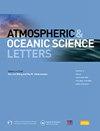Prediction of net primary productivity in the middle-to-high latitudes of Eurasia based on snow and soil temperature
IF 2.3
4区 地球科学
Q3 METEOROLOGY & ATMOSPHERIC SCIENCES
引用次数: 0
Abstract
Net primary productivity (NPP) is the net accumulation of organic matter by vegetation through photosynthesis and serves as a key indicator for exploring vegetation responses to climate change. Considering the remote and local impacts of soil heat capacities on vegetation growth through pathways of atmospheric circulation and land–atmosphere interaction, this paper develops a statistical prediction model for NPP from April to June (AMJ) across the middle-to-high latitudes of Eurasia. The model introduces two physically meaningful predictors: the snow water equivalent (SWE) from February to March (FM) over central Europe and the FM local soil temperature (ST). The positive phase of FM SWE triggers anomalous eastward-propagating Rossby waves, leading to an anomalous low-pressure system and cooling in the middle-to-high latitudes of Eurasia. This effect persists into spring through snow feedback to the atmosphere and affects subsequent NPP changes. The ST is closely related to the AMJ temperature and precipitation. With positive ST anomalies, the AMJ temperature and precipitation exhibit an east–west dipole anomaly distribution in this region. The single-factor prediction scheme using ST as the predictor is much better than using SWE as the predictor. Independent validation results from 2009 to 2014 demonstrate that the ST scheme alone has good predictive performance for the spatial distribution and interannual variability of NPP. The predictive skills of the multi-factor prediction schemes can be improved by about 13 % if the ST predictor is included. The findings confirm that local ST is a predictor that must be included for NPP prediction.
摘要
净初级生产力 (NPP) 是植被通过光合作用积累机物质的净效益, 是探索植被对气候变化响应的关键指标. 考虑到陆面热力异常通过陆气相互作用和大尺度环流对植被生长的影响, 本文研制了欧亚中高纬地区4–6月NPP预测模型. 该模型引入了两个具有明确物理意义的预测因子: 欧洲中部2–3月的雪水当量 (SWE) 和2–3月局地土壤温度 (ST). SWE的正异常会触发异常东传的Rossby波, 导致下游出现位势高度负异常并引起降温. 通过雪和温度的正反馈, 这种异常低温持续到春季并使得NPP下降. ST与随后季节的温度和降水密切相关, 当ST出现正异常时, 该地区的4–6月温度和降水呈现出东西向偶极子异常分布.对比各方案的预测效果发现, ST比SWE有更好的预测能力. 2009–2014年独立后报结果显示, ST方案对NPP的空间分布和年际变率都有很好的预测效果. 交叉检验的结果显示, 多因子方案中引入ST后能提高模型13 %的预测技巧.
根据积雪和土壤温度预测欧亚大陆中高纬度地区的净初级生产力
净初级生产力(NPP)是植被通过光合作用积累的有机质,是研究植被对气候变化响应的重要指标。考虑到土壤热容通过大气环流和陆-气相互作用对植被生长的局地和远地影响,建立了欧亚大陆中高纬度地区4 - 6月NPP (AMJ)的统计预测模型。该模式引入了两个具有物理意义的预测因子:中欧地区2 - 3月的雪水当量(SWE)和FM地区的土壤温度(ST)。FM SWE正相位触发异常东向传播的罗斯比波,导致欧亚大陆中高纬度地区出现异常低压系统和降温。这种效应通过降雪反馈到大气,持续到春季,并影响随后的NPP变化。温度与AMJ温度和降水密切相关。在正ST异常的情况下,该地区的温度和降水呈东西偶极子异常分布。使用ST作为预测器的单因素预测方案比使用SWE作为预测器的单因素预测方案要好得多。2009 - 2014年的独立验证结果表明,单独使用ST方案对NPP的空间分布和年际变化具有较好的预测效果。如果包括ST预测器,多因素预测方案的预测能力可提高约13%。研究结果证实,当地温度是一个预测因子,必须包括在NPP预测中。摘要净初级生产力(NPP)是植被通过光合作用积累机物质的净效益,是探索植被对气候变化响应的关键指标。考虑到陆面热力异常通过陆气相互作用和大尺度环流对植被生长的影响,本文研制了欧亚中高纬地区4 - 6月NPP预测模型。该模型引入了两个具有明确物理意义的预测因子:欧洲中部2 - 3月的雪水当量(层面)和2 - 3月局地土壤温度(ST)。中国科学院院士、中国科学院院士、中国科学院院士、中国科学院院士、中国科学院院士等。通过雪和温度的正反馈,这种异常低温持续到春季并使得NPP下降。圣与随后季节的温度和降水密切相关,当圣出现正异常时,该地区的4 - 6月温度和降水呈现出东西向偶极子异常分布。【中文译文】2009-2014年,中国科学院院士、院士、院士、院士、院士、院士。这是一个很好的例子。
本文章由计算机程序翻译,如有差异,请以英文原文为准。
求助全文
约1分钟内获得全文
求助全文
来源期刊

Atmospheric and Oceanic Science Letters
METEOROLOGY & ATMOSPHERIC SCIENCES-
CiteScore
4.20
自引率
8.70%
发文量
925
审稿时长
12 weeks
 求助内容:
求助内容: 应助结果提醒方式:
应助结果提醒方式:


